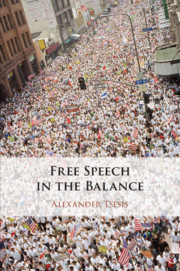Book contents
- Free Speech in the Balance
- Free Speech in the Balance
- Copyright page
- Dedication
- Contents
- Preface
- Acknowledgments
- Part I Theory
- 1 Formalism and Categorical Doctrine
- 2 Dominant Academic Approaches to Free Speech
- 3 Free Speech and Proportionality
- 4 Civic Community and Social Context
- Part II Application
- Notes
- Index
4 - Civic Community and Social Context
from Part I - Theory
Published online by Cambridge University Press: 06 November 2020
- Free Speech in the Balance
- Free Speech in the Balance
- Copyright page
- Dedication
- Contents
- Preface
- Acknowledgments
- Part I Theory
- 1 Formalism and Categorical Doctrine
- 2 Dominant Academic Approaches to Free Speech
- 3 Free Speech and Proportionality
- 4 Civic Community and Social Context
- Part II Application
- Notes
- Index
Summary
The First Amendment is a normative component of the US Constitution’s system of representative governance, instituted for persons to pursue their happiness by safeguarding fundamental rights essential to general welfare and safety.257 The US government is built on a foundation that safeguards deliberation, self-expression, self-affirmation, and scientific pursuits. These rights are not only guarded by the Amendment, by statutes, and by judicial opinions, but by the very structure of a government created by the people to preserve their inalienable interests in liberty and equality. The nation’s founding statement of purpose, which is set out by the Declaration of Independence, recites a commitment to establish a nation to protect ordinary citizens’ safety and happiness.
- Type
- Chapter
- Information
- Free Speech in the Balance , pp. 57 - 74Publisher: Cambridge University PressPrint publication year: 2020

